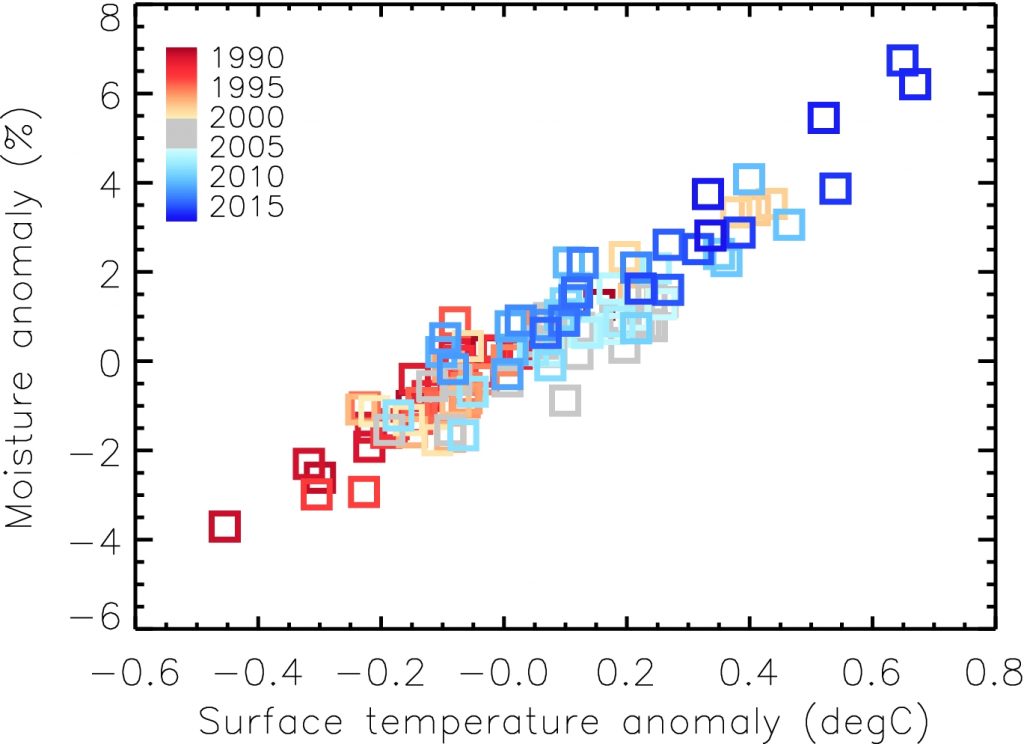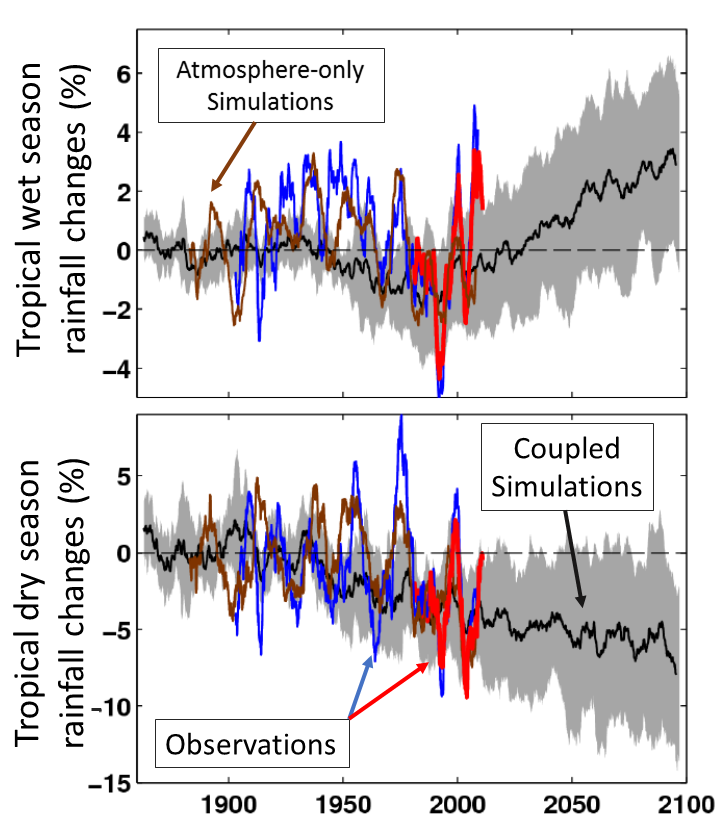The fickle nature of weather patterns is ultimately responsible for the where and when of tropical rainfall extremes which wreak damage on agriculture, infrastructure and people. Tropical cyclones, such as Enawo which battered Madagascar in March, can severely impact low-lying, highly populated regions through intense rainfall combined with strong winds and storm surges. Explosive thunderstorms operating at smaller spatial scales can generate flash flooding and may lead to devastating landslides in mountainous terrain. A sustained dearth of rainfall or multiple failed seasonal rains, as implicated in drought currently impacting Somalia, Kenya and Ethiopia, are also inextricably linked with evolving weather patterns, often driven by the slower heart-beat of the oceans as they pace out the internal rhythm of El Niño Southern Oscillation and its decadal counterparts.
Guest post by Richard Allan
Despite the dominant role of chaotic atmospheric and oceanic fluctuations in meting out extremes of weather, there are several controlling factors at the largest terrestrial scales. Barely perceptibly, they nudge the distribution of extremes away from present day patterns through global climatic changes caused by the influence of human activities on the planet’s energy budget. Rising concentrations of greenhouse gases in the atmosphere are slowly but inexorably perturbing the climate system, modifying the ultimate fuel for rainfall extremes: water and energy.
While detailed computer simulations capture the fluid, thermodynamic essence of the atmosphere, the processes building up to rainfall extremes, the fine-scale detail of convective storms, must be approximated using a simplified approach but very much rooted in physics. The reliability of future projections out across progressively more distant decades relies on fundamental linkages between the skill in depicting essential physics at the tens to hundreds of kilometre scales and the unrepresented detail which determines impacts.
Nevertheless, there is a physical basis for anticipating substantial yet contrasting changes across wet and dry meteorological regimes as the climate warms.

As global temperatures increase, the invisible, gaseous water vapour in the air becomes more abundant, to the tune of 7% for each degree Celsius of tropical warming. This is incontrovertible, observable (see Figure 1) and has huge implications for climate. Water vapour amplifies climate change through the most well-known vicious cycle (warming leads to more atmospheric moisture and a more potent greenhouse effect which feeds back on the warming, amplifying the magnitude of the climate’s response to rising greenhouse gases). This increase in moisture crucially also fuels a greater intensity of rainfall.
When considering the vast areas experiencing the seasonal progression of the tropical rainy belt, the simplest result of a warming planet is the intensification of the wet seasons. The chaotic nature of weather patterns dictates that seasonal rains may fail one year while be supercharged in another, depending on the precise position and mood of this rainy belt as it straddles the hemispheres. Yet when conditions are right for a seasonal deluge, it will be more intense in a warmer world due to the more copious quantities of available moisture blown in by the winds.
Things get more complicated when considering the dry zones and dry seasons. Averaged over many years, more atmospheric moisture arrives from over the ocean than is exported from land. If this wasn’t the case, then rivers would have to run in reverse! But for the dry season, a warmer, thirstier atmosphere can more effectively sap the ground of its moisture and temporarily export moisture out of the region.
All this points toward an intensification of the wet and dry seasons as the planet warms but this simplistic message is complicated by several factors which include:
- The tropical rainy belt alters in precise location from year to year and its position also responds to climate change;
- Tropical cloud and winds rapidly adjust to modified heating patterns from greenhouse gases and aerosol particle pollution that ultimately are driving global climate change over longer time-scales, the slow pace of which is determined by the capacity of our vast oceans to take up excess heat;
- The effect of these radiative forcings of climate and chaotic weather fluctuations confound detection of wetter wet seasons and drier dry seasons that relate to increasing moisture;
- Possible long-term changes in moisture within the soil can feed back on the atmospheric circulation and rainfall characteristics, complicating the picture locally;
- Finally, how arid a location is depends on much more than merely precipitation.
While “dry-gets-drier” does not apply in a simplistic way over land, intriguing signals of amplification in the seasonality of rainfall are apparent over tropical land with chaotic fluctuations superimposed upon longer-term trends (Figure 2). More intense dry seasons have potentially serious consequences for ecosystem productivity.
Yet these signals are confounded by dominating variations in weather patterns and by movement in the climatological locations of wet and dry regimes over time. Better defining of the wet seasons is an important step in detecting and monitoring changes important for impacts on societies. The intensification of wet and dry seasons appears a likely but not guaranteed response in a warming climate yet substantial changes in rainfall, increases or decreases, are projected for considerable proportions of tropical land over the 21st century.

The where, when and scale of drought and deluge will continue to centre on the complex evolution of the atmosphere and ocean circulation but weather patterns are already being nudged away from their climatological normal. Limiting impacts requires substantial and sustained cuts in greenhouse gas emissions to tackle the root causes of warming but also crucial is better preparedness through supporting the development of climate resilient societies.
References
Allan et al. (2014) Physically consistent responses of the global atmospheric hydrological cycle in models and observations, Surv. Geophys., doi:10.1007/s10712-012-9213-z.
Berg et al.(2016) Land-atmosphere feedbacks amplify aridity increase over land under global warming, Nature Climate Change, doi:10.1038/nclimate3029
Bony et al. (2013) Robust direct effect of carbon dioxide on tropical circulation and regional precipitation, Nature Geoscience doi:10.1038/ngeo1799
Byrne & O’Gorman (2015) The response of precipitation minus evapotranspiration to climate warming: Why the “wet-get-wetter, dry-get-drier” scaling does not hold over land, J. Climate, doi:10.1175/JCLI-D-15-0369.1
Chadwick et al.(2015) Large rainfall changes consistently projected over substantial areas of tropical land. Nature Climate Change, doi:10.1038/nclimate2805
Chou et al. (2013) increase in the range between wet and dry season precipitation, Nature Geoscience, doi:10.1038/ngeo1744
Dunning et al. (2016) The onset and cessation of seasonal rainfall over Africa, J Geophys. Res., doi:10.1002/2016JD025428
Greve et al. (2014) Global assessment of trends in wetting and drying over land, Nature Geoscience, doi:10.1038/ngeo2247
Hegerl et al. (2015) Challenges in quantifying changes in the global water cycle. Bull. Am. Meteorol. Soc., doi: 10.1175/BAMS-D-13-00212.1
Held & Soden (2006) Robust responses of the hydrological cycle to global warming. J Clim doi: 10.1175/JCLI3990.1
Liu & Allan (2013) Observed and simulated precipitation responses in wet and dry regions 1850-2100, Environ. Res. Lett., doi:10.1088/1748-9326/8/3/034002
Murray-Tortarolo et al. (2016), The dry season intensity as a key driver of NPP trends, Geophys. Res. Lett., doi:10.1002/2016GL068240
Trenberth et al. (2014) Global warming and changes in drought. Nature Climate Change, doi:10.1038/nclimate2067
This post originally appeared on the Weather & Climate blog.
One thought on “Changing wet and dry seasons”